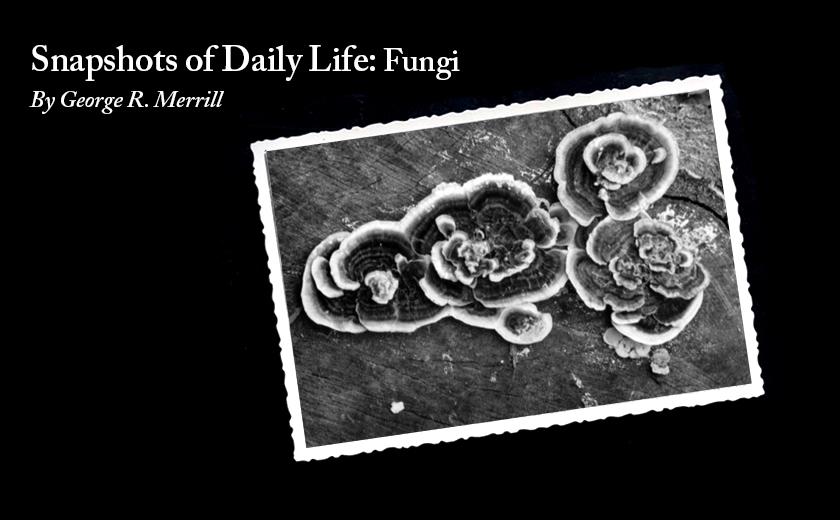Transformations occur daily. I see some from the corner of my eye.
Since I have an unruly attention span, like a child or a dog’s, my thoughts are easily diverted by whatever catches my eye at the moment. Some peripheral object I catch from the corner of my eye will suddenly command my attention and arouse my curiosity. Immediately my mind begins working backwards from the fragment itself and starts wondering about the source from which it came.
And so recently, from the corner of my eye, I saw fungi formed next to our porch stairs. They grew on the stump of a fallen birch tree. They made a lovely formation. My reaction was quite contrary to the feeling I’ve generally held about molds and fungi, namely, that they’re yukky.
I wanted to photograph the formation ––black and white, of course–– but it was situated in such a way as to make camera access very difficult. I nevertheless attempted it. It turned out to be a production to get positioned for getting a good image –– while my arthritic back protested –– but finally I did. I thought the formation of the fungus, enthralling. A picture of it accompanies this essay.
A fungus, among other things, is a visible witness to the ecological phenomena of organic decomposition. I like to think about it as yet another manifestation of transformation that is as fundamental a process to our spirituality as it is of organic life. Transformation is the way of the world.
Transformation is also at the heart of hope. Hope is about sitting quietly with an intimation that we are becoming but just what, we’re not really sure. Generally, our hope is that whatever may happen, when we get there, all will be well. Just what we are becoming is never clear except for some happy souls who are sure of what’s going to happen next. To them I can only say how Buddhists would offer the thought that they are indulging illusions, fragments of imagination that are best not taken seriously.
We live, today, in a black and white world; psychologists and philosophers call it ‘dualistic.’ Politics is one example; its soundbites are framed to have us believe things are either this way or that. I think this is grossly misleading. Things vary far too much in life to assume that we can nail anything down for sure. Being uncertain, however is an anxious feeling. Having opinions is reassuring and can offer us comfort by assuring ourselves that we know what in fact is unknowable. I’ve noticed that those who suffer this uncertainty acutely, are the most strident in the expression of their opinions.
One reason we can never know what’s next is the way time works. Time transforms everything big and small. Time has ways of exalting the humble and humbling the exalted or to say it differently, messing up the best plans we ever made or redeeming out grossest snafus we’ve committed. In that regard I’m fond of the old story of Joe Jacobs, a humble man and a professional fight manager. One night in 1932, Jacobs, upon hearing that his man lost the decision, seized the mic and shouted. “We was robbed.’ I would have imagined his grammatical error would have consigned his declaration to oblivion. Instead it earned him literary immortality. You never know just how things will play out over time.
The downed birch tree where I saw this lovely fungus is another instance of the unexpected transformations that can surprise and may offer significant comfort. The birch tree was a beauty. It grew close to the house and for over fifty years offered shade for the porch. Birches like this are more common to northern climes so I was often amazed and especially pleased that it fared so well here in the mid-Atlantic.
The time came when the tree began ailing. Leaves turned brown, limb by limb. Was it dying? We consulted an arborist the way patients anxiously turn to doctors with their complaints, fearing the worst but hoping for the best. There was nothing he could do. Saddened, we postponed the inevitable until we finally had it cut down. When it was gone I felt as if I had lost a limb. Only the stump remained, like a grave marker, inches above the ground and close to the house, as I’ve seen in some family cemeteries around old farm houses in rural areas here on the Shore.
It was two years later when I noticed the fungus for the first time.
Seeing beauty in the formation of the fungus softened the harder edges of my mourning in ways I would never have suspected. I don’t know if I shall ever completely get over the fact that the tree is gone from my life but I have found some pleasure in the beauty of the transformational process that had been effected on the root stump. A new life of a very different kind had appeared in this transformation. It appeared wholly unexpected and I saw it first from the corner of my eye.
Columnist George Merrill is an Episcopal Church priest and pastoral psychotherapist. A writer and photographer, he’s authored two books on spirituality: Reflections: Psychological and Spiritual Images of the Heart and The Bay of the Mother of God: A Yankee Discovers the Chesapeake Bay. He is a native New Yorker, previously directing counseling services in Hartford, Connecticut, and in Baltimore. George’s essays, some award winning, have appeared in regional magazines and are broadcast twice monthly on Delmarva Public Radio.



Write a Letter to the Editor on this Article
We encourage readers to offer their point of view on this article by submitting the following form. Editing is sometimes necessary and is done at the discretion of the editorial staff.